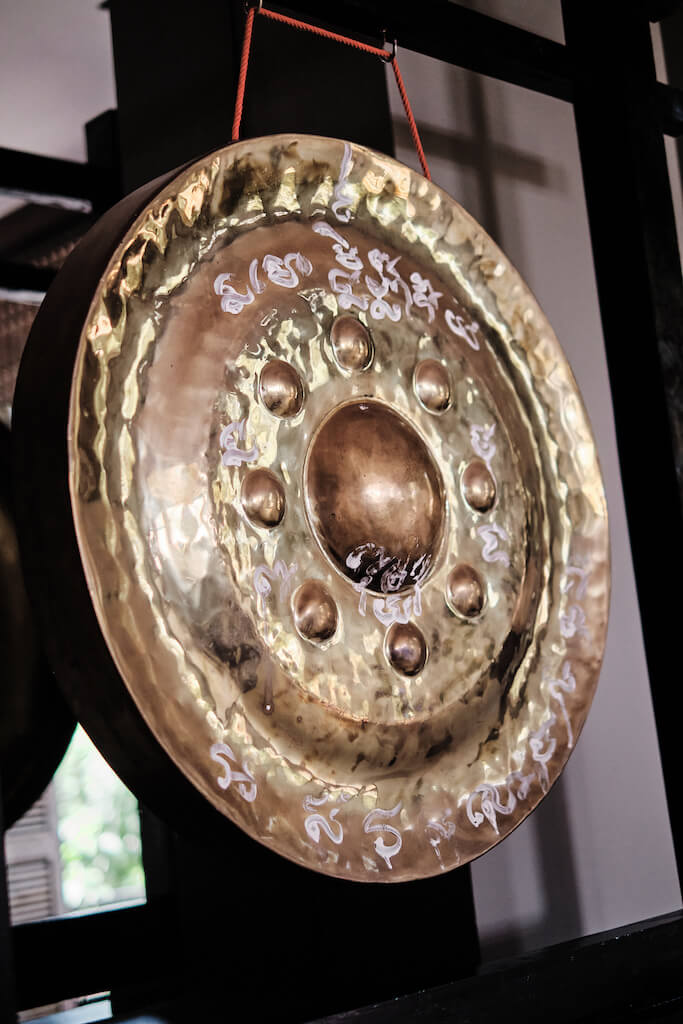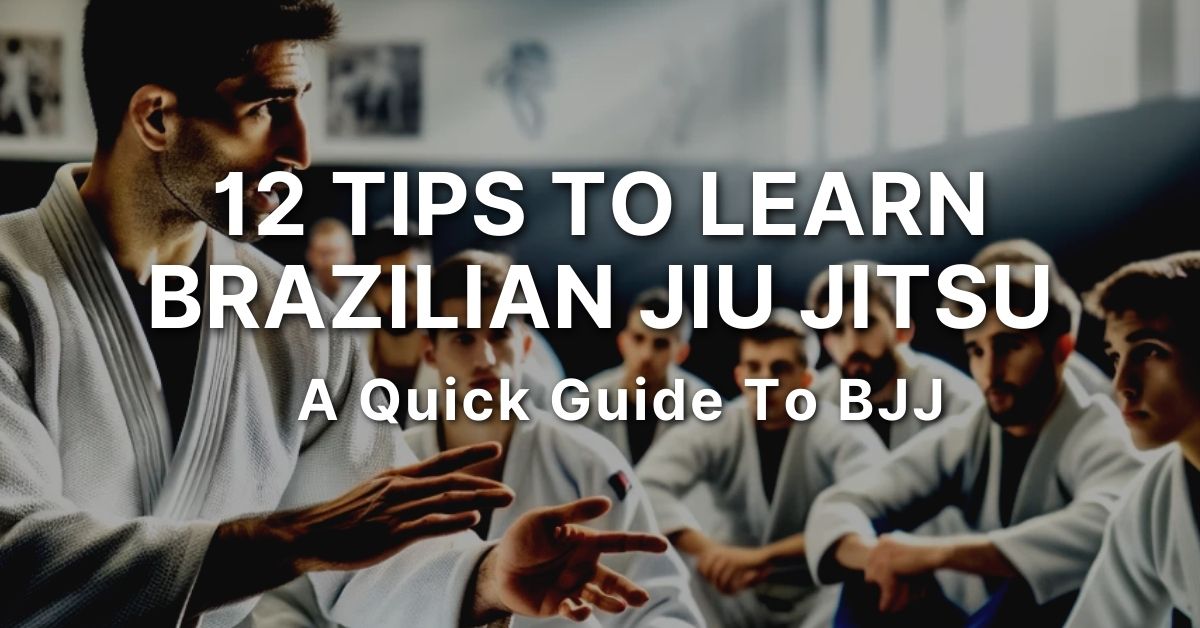Are you looking for a way to learn Brazilian jiu jitsu? BJJ is an exciting martial art where you have to understand the basics before advancing your skills.
This article provides an easy-to-follow guide on the 12 tips you need to get on the path to becoming an expert in BJJ. Arm yourself with the necessary knowledge and you will be well on your way to tackle any situation!
12 Tips To Learn Brazilian Jiu Jitsu
Getting started with BJJ can be a daunting task.
There is so much to learn, so many moves and techniques to remember, and it is all wrapped up in an unfamiliar language.
Fortunately, once you take the time to break each skill down into manageable pieces, learning BJJ can become a fun and rewarding hobby.
Here are 12 tips that will help you to learn Jiu Jitsu fast:

Find a Brazilian Jiu Jitsu School Near You
For newbies who want to train BJJ, finding a good school and instructor to train with is a great start.
Before enrolling at a school, do your research to find one with instructors who provide quality instruction.
Look for experienced teachers who understand the fundamental concepts of this sport and are able to teach basic movements like sweeps and guard control properly.
Also, see if there is any type of mentorship program or additional resources offered outside of class that might be beneficial as you progress in your BJJ training.
Apart from quality instruction, seeking out good sparring partners is another essential component when it comes to learning Brazilian Jiu Jitsu quickly. Ask around at schools in your local area or try joining one of the many online forums where BJJ enthusiasts interact regularly.
Through these outlets, you can gain access to knowledge about different types of sparring partners as well as tips for selecting an appropriate gym for your specific skill level.
Finding like-minded individuals who share similar goals will greatly increase your chances of achieving success when pursuing your passion for learning Brazilian Jiu Jitsu over time!
Sign Up For Your First BJJ Class
For those looking to learn BJJ, signing up for your first class is the most important step.
But if you want to master the new techniques and moves of this martial art, then going in with the right preparation is essential.
Before signing up for your first class, do some research into local dojos and gyms that offer BJJ courses.
Ensure that you take the time to read reviews of both instructors and classes to find the right fit for you. After choosing a gym, call or email to arrange an introductory class or private session so you can have your questions answered.
Once enrolled in a BJJ course, start by preparing yourself mentally and physically.
Familiarize yourself with some of the key terms of BJJ like “roll” and “tap out” as well as understand what will be expected of you in training sessions such as not eating before practice, wearing minimal jewelry etc.
Most importantly take a beginner mentality; set achievable goals for each session such as focusing on proper technique instead of simply winning against opponents
On your first day make sure you come equipped with comfortable workout clothes ,breathable material such as rash guards are especially recommended for hygienic purposes.
Also bring water on hand so you remain hydrated throughout practice sessions.
Don’t hesitate if there is anything else needed during instruction , your instructor will be happy to help you out.
Lastly when asking questions don’t forget to always ask your sparring partner prior engaging with them , just as any other martial art – safety should always come first!
Signing up for even just one class of BJJ will help give any beginner an edge in beginning their knowledge and appreciation around Brazilian Jiu Jitsu!
Buy A Jiu Jitsu Gi
If you are learning Brazilian Jiu Jitsu (BJJ) it is important to purchase a proper Jiujitsu Gi (uniform).
The quality of the Gi you choose has an influence on the effectiveness and duration of your training.
A good Gi should have a good fit, excellent mobility and is made from durable materials.
Make sure to get help from someone who knows about Gis when purchasing.
Begin With A White Belt
The best way for a beginner to get started in jiu jitsu is to begin with a white belt.
This will give them an organized approach to training and also provide an understanding of the fundamentals, concepts and techniques of BJJ.
At the beginning of training, it’s important to know what to expect and how to practice safely.
Mastering the white belt give you a strong foundation and understanding of the basic concepts of jiu jitsu.
Once you’ve spend enough time training, you will be a blue belt in no time!
Get Protective Gear
Before you start learning Brazilian jiu-jitsu, it is important to get the right protective gear.
- A mouth guard is a must, as it will protect your teeth from getting damaged during grappling and sparring.
- Knee pads are also essential for protecting your knees from mat burns and other abrasions that may occur during training and competition. Although most academies provide loaner equipment, it’s always best to use your own protective gear to ensure it fits and provides sufficient protection.
- To properly protect yourself, you should also look into getting Gi pants with reinforced knee padding and extra padding in the seat area.
- You may also want to wear a rashguard or compression shirt underneath your gi top if you sweat a lot when training – this helps keep your jiu-jitsu gi clean and increases breathability. Additionally, it’s important to wear wrestling shoes to provide greater traction so you can move more quickly on the mats when performing sweeps, grips or takedowns.
Investing in good quality protective gear for Brazilian jiu-jitsu is an important step for safe training sessions – not only will it prevent you from getting injured but it will also help increase confidence which can result in better performance in competitions.
Stay Clean
Personal hygiene is a key component of jiu jitsu.
As you go through your technical training at the gym, you will be engaging in regular close contact with your partner – both in terms of sweaty physical contact from the ground and during grappling, and even some light contact during sparring.
It is important to ensure that both you and your partner remain clean and hygienic to prevent any irritation or infection due to bacterial accumulation.
Make sure to shower before every session and wear fresh clothes for each session.
Each time that you come in for practice, remember to bring a towel to wipe off after rolling on the ground or when partnering with someone else.
Additionally, wear appropriate clothing designed for BJJ such as kimonos, rashguards, and gym shorts that are comfortable yet durable enough handle the rigors of physical training.
Furthermore, make sure your clothing is washed regularly and never shared with another partner.
By staying clean when visiting the dojo for class time, this will also help maintain a pleasant atmosphere for everyone in the gym who shares a love of jiu-jitsu – without any concern over unnecessary infections or illnesses!
Be Respectful
Although combat based, jiu jitsu should be noted that the art is more about self-defense than simply attacking an opponent, and to this end it requires respect for both yourself and those around you.
As such, your instructor and training partner should both be respected throughout the entire lesson, from warm-up to cool-down.
This includes acknowledging techniques taught by the instructor, treating training partners with good manners, and displaying a proper attitude towards respect in general.
Even if holding back from sparring with full force – as recommended by some instructors for less experienced students – remembering to be respectful at all times will help keep everybody safe during training and create a better atmosphere for everyone involved.
In addition, BJJ ranks (whether belts or stripes) should always be respected regardless of affiliation (such as the Gracie Jiu Jitsu Belt System; even if a person’s rank is lower than yours within a particular school they may have more experience or understanding within the art as a whole so it’s important to treat each other with the same level of respect regardless of rank or experience.
Respecting yourself is also key; give yourself time off (at least once per week) to rest in order to avoid the potential ‘burn out’ of training too often over short periods of time.
Good nutrition is also essential; seek nutritional advice from experienced BJJ practitioners in order to building strength over time while avoiding unhealthy food options when available as these might lead to deficiencies later down the line which could impede your development into Brazilian Jiu Jitsu.
Don’t Neglect Stretching And Warming Up
When learning Brazilian jiu-jitsu, one of the most important aspects to consider is your flexibility and mobility.
An increased range of motion before the training session will ensure concise movements from beginning to end, decreasing the risk of any unwanted strain or soreness.
Stretching and warm ups should never be neglected – use this 3-5 minute window before each session to perform a dynamic warm-up which involves exercises such as arm circles, body circles, burpees etc. This will help improve circulation and shorten recovery post your session.
Furthermore, stretching out at the conclusion of each practice keeps muscles relaxed, helps you avoid injury and promotes longevity in your Jiu-jitsu journey.
It’s also important to make sure your body is properly conditioned for the rigors that come with Brazilian jiu-jitsu training.
Regular exercises such as push ups, sit ups and squats help keep you fit and prevent possible injuries in the future by strengthening tendons and ligaments.
Practice Basic BJJ Techniques
Similarly to other martial arts, developing a knowledge base and competency in the fundamental techniques of jiu jitsu is a key milestone to becoming an adept martial artist.
Before attempting to practice more complicated or advanced moves, mastering the basic jiu jitsu skills should be your top priority.
Start by allocating adequate time for training in order to become familiar with the major techniques and their respective principles.
Sparring with other practitioners is a great way to put the BJJ fundamentals into practice and learn how they work in real life sparring situations.
Additionally, spending time drilling each technique thoroughly, such as the granby roll, forward roll, backward rolls, hip escape, solo drills, mount position will help ingrain them into muscle memory so that you can instinctively know how to react during sparring rounds or even self-defense situations.
Numerous outlets, including video sources and books, offer instruction on all fundamental techniques such as grappling postures, guard types like open guard or closed guard and takedowns like throw or body lock.
Additional instruction on fundamental moves like sweeps or forward rolls should also be generously practiced until the desired proficiency is achieved before moving onto other more intricate moves.
Practicing basic BJJ techniques takes effort over time but will produce valuable defensive reflexes to support any dominance scenario with confidence and skill. Keep up with training often and do not forget these essential steps!
Train Regularly
If you are looking to learn BJJ, then one piece of advice that is essential to understand is the importance of consistency and regular training in any combat sports.
Consistent practice will help develop your skills at a rapid pace as well as help you pretty good technique. It also helps form fundamental habits, so it’s important to revise basics often in order to stay on top of your game.
Regular training can be supplemented by techniques and drills designed to help you improve in specific areas.
Do not limit yourself by only attending classes and repeating basic technique – it’s just as important if not more so, to practice more advanced movements and applying those techniques with different partners.
Learning how individual jiu-jitsu moves transition from one technique into another will make your current skill set more versatile and allow for smoother transitions when sparring or competing against other practitioners.
To ensure you can progress at a high rate, it is recommended that you attend class at least 3 times per week while supplementing with private lessons or outside instruction whenever possible. Assembling a team that helps each other improve is also essential; having friends work together on improving will go further than going solo all the time!
Spar With A Partner
One of the best ways to learn Brazilian Jiu Jitsu (BJJ) is to spar with a partner. As a BJJ practitioner, you should look for someone with a similar skill level as yourself; that way, you can challenge and learn from one another without having to worry about overwhelming each other or getting injured.
If all you do is drill techniques against a compliant partner, you won’t get the true experience of what it takes to be successful in the sport. Nothing compares to actual live rolling with someone who has the same level of knowledge and skill as yourself.
Moreover, your partners will help you understand which techniques work better against specific types of opponents and physical attributes.
You might discover that something works well for a partner but fails against another one because they have different body types or posture adjustments.
This type of real-world experience will provide you with invaluable insights as to what moves work best in different scenarios.
Furthermore, your partners can offer valuable feedback regarding form and technique so pay close attention when they make suggestions and take their advice seriously!
Tap To Signal Submission
Submitting is a common way of ending rounds in jiu jitsu.
It is important to learn the etiquette and protocols of tapping out quickly and clearly so your opponent recognizes and understands it when you need to end an exchange or move. Learning how to “tap” correctly also facilitates smoother, faster-paced sparring sessions.
The process of tapping is simple.
All you need to do is lightly place your free hand flat on the ground or gently bump your opponent twice with the same hand that you are using for guard or other technique.
This allows them to recognize that you are signaling submission, so they can immediately stop whatever move they were applying on you – earning both participants respect for each other and the sport of BJJ as a whole.
Depending on your belt level, some instructors might teach more complex ways of submitting such as verbally saying “Stop,” but for new students, simply learning how to tap should be enough during their training sessions.
The goal here is not only learning how to tap out in order not get injured but also teaching newbies a sense of respect when rolling with someone else or when competing against another practitioner in tournaments or competitions.
Ultimately, tapping effectively demonstrates control over training scenarios and makes both opponents aware that they are abiding by mutual rules enforced among all practitioners regardless of their rank or course level.


0 Comments